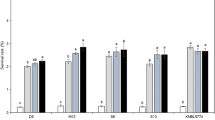Abstract
Survival of alginate-entrapped cells of Azospirillum lipoferum was studied during dehydration using a dry air stream and during prolonged storage at various constant water activity values (aw). During the drying operation, the viability loss remained almost constant from the initial water content to 0.35 g water/g dry weight (DW) corresponding to a 98.5% water removal, strongly increased until a water content of 0.25 g/g DW and then stopped until the end of the drying operational (final aw 0.18). A water content of 0.25 g/g DW (aw=0.55) corresponded to the critical point of the moisture sorption isotherm curve from which water became restricted to the dry material. A high drying rate (5 g/g DW per hour) was shown to be more detrimental for cell viability than a low drying rate (1.18 g/g DW per hour). When the product was stored in a closed chamber with a regulated aw (0.23), the number of living cells decreased during a short period (less than 15 days) corresponding to the product aw stabilization, and then remained constant for more than 150 days. In addition, cell survival during storage was not affected by aw values in the range 0–0.55. Above aw=0.55, the higher the aw and the storage duration, the lower the residual survival percentage. The influence of the drying and storage conditions on the cell death rate are discussed with regard to both the mechanisms generally involved in viability loss and the hydration properties of water.
Similar content being viewed by others
References
Antheunisse J, Arksteijn-Dijksman L (1979) Rate of drying and the survival of microorganisms. Antonie Van Leeuwenhoek J Microbiol 45:177–184
Bashan Y (1986) Alginate beads as synthetic inoculant carriers for slow release of bacteria that affect plant growth. Appl Environ Microbiol 51:1089–1098
Bashan Y, Levanony H (1990) Current status of Azospirillium inoculation technology: Azospirillum as a challenge for agriculture. Can J Microbiol 36:591–608
Beker MJ, Rapoport AI (1987) Conservation of yeast by dehydration. Adv Biochem Eng Biotechnol 35:127–172
Berge O, Fages J, Mulard D, Balandreau J (1990) Effects of inoculation with Bacillus circulans and Azospirillum lipoferum on crop-yield in field grown maize. Symbiosis 9:259–266
Corry JEL (1975) The effect of water activity on the heat resistance of bacteria. In: Water Relat Foods. Proc Int Symp, pp 325–337
Csonka LN (1989) Physiological and genetic responses of bacteria to osmotic stress. Microbiol Rev 53:121–147
Dommergues YR, Diem HG, Divies C (1979) Polyacrylamide-entrapped Rhizobium as an inoculant for legumes. Appl Environ Microbiol 37:779–781
Duckworth RB (1981) Solute mobility in relation to water content and water activity. In: Rockland LB, Stewart GF (eds) Water activity: influences on food quality. Academic Press, New York, pp 295–318
Fages J (1990) An optimized process for manufacturing an Azospirillum inoculant for crops. Appl Microbiol Biotechnol 32:473–478
Fages J (1992) An industrial view of Azospirillum inoculants: formulation and application technology. Symbiosis 13:15–26
Fages J, Mulard D (1988) Isolement de bacteries rhizosphériques et effect de leur inoculation en pots chez Zea mays. Agronomie 8:309–314
Graham-Weiss L, Bennet ML, Paau AS (1987) Production of bacterial inoculants by direct fermentation on nutrient-supplemented vermiculite. Appl Environ Microbiol 53:2138–2141
Jung G, Mugnier J, Diem HG, Dommergues YR (1982) Polymer-entrapped Rhizobium as an inoculant for legumes. Plant Soil 65:219–231
Madkour MA, Smith LT, Smith GM (1990) Preferential osmolyte accumulation: a mechanism of osmotic stress adaptation in diazotrophic bacteria. Appl Environ Microbiol 56:2876–2881
Marshall B, Coote GG, Scoot WJ (1974) A study of factors affecting the survival of dried bacteria during storage. CSIRO Aust Div Food Res Tech Pap 39:1–29
Mary P, Ochin D, Tailliez R (1985) Rates of drying and survival of Rhizobium meliloti strains during storage at different relative humidities. Appl Environ Microbiol 50:207–211
Mink RW, Patterson JA, Hespell RB (1982) Changes in viability, cell composition, and enzyme levels during starvation of continuously cultures (ammonia-limited) Selenomonas ruminantium. Appl Environ Microbiol 44:913–922
Mugnier J, Jung G (1985) Survival of bacteria and fungi in relation to water activity and the solvent properties of water in biopolymers gels. Appl Environ Microbiol 50:108–114
Okon Y, Hadar Y (1987) Microbial inoculants as crop-yield enhancers. CRC Crit Rev Biotechnol 6:61–85
Paul E, Mulard D, Blanc P, Fages J, Goma G, Pareilleux A (1990) Effect of partial O2 pressure, partial CO2 pressure and agitation on growth kinetics of Azospirillum lipoferum under fermentor conditions. Appl Environ Microbiol 56:3235–3239
Somasegaran P (1985) Inoculant production with diluted liquid cultures of Rhozobium spp. and autoclaved peat: evaluation of diluents, Rhizobium spp. peats, sterility requirements, storage and plant effectiveness. App lEnviron Microbiol 50:398–405
Van den Berg C, Bruin S (1981) Water activity and its estimation in food systems: theoretical aspects. In: Rockland LB, Stewart GF (eds) Water activity: influences on food quality. Academic Press, New York, p 1
Author information
Authors and Affiliations
Additional information
Correspondence to: A. Pareilleux
Rights and permissions
About this article
Cite this article
Paul, E., Fages, J., Blanc, P. et al. Survival of alginate-entrapped cells of Azospirillum lipoferum during dehydration and storage in relation to water properties. Appl Microbiol Biotechnol 40, 34–39 (1993). https://doi.org/10.1007/BF00170425
Received:
Accepted:
Issue Date:
DOI: https://doi.org/10.1007/BF00170425




